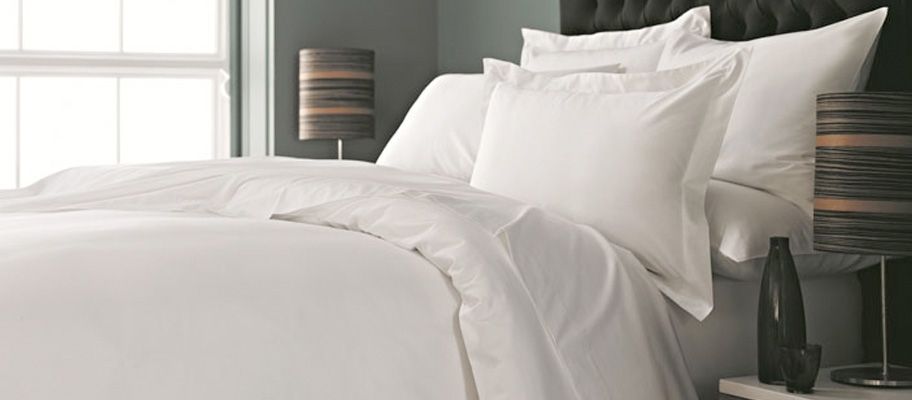We use cookies to give you the best possible experience. To accept cookies continue browsing, or view our Cookies Policy to find out more.
How to Avoid Bobbling or Pilling on Your Bed Linen

Everything you do for your establishment has your guest’s happiness in mind. That’s why it can be so frustrating when something you buy doesn't last as long as you may expect it to. Bobbling or pilling is a common side effect of using and washing linen over time. Why does it happen and what can you do about it?
Why does my linen bobble or pill?
Material can bobble or pill due to a surface defect that’s made up of small fibres. Pilling ends up giving your bed linen the appearance of having lots of little balls of fibre stuck to the fabric. Long term usage and repeated washing of your linen can fray the fibre endings, tangling and leading to tiny knots. Materials that have a tendency to pill the most are cotton, wool, nylon, polyester and acrylic. The good news is that wool pilling tends to diminish over time as the wool fibres work themselves free of the fabric and fall off. Synthetic fibres, however, are at an increased risk of pilling as the strong fibres can keep a firm hold of the pills.
While the textile industry does its best to reduce the risk of bobbles and pills - including more twists per inch in the yarn, singeing loose fibres from the surface of textiles and adding chemical treatments during the manufacturing process - it can't currently be completely eliminated. However, good care of linen and taking the steps in the next section can significantly reduce the risk.
How can I stop bobbling from appearing on my bed linen?
There are a number of things you can do to reduce the risk of bobbling on bed linen.
- Think about the material of your bed linen. 100% cotton is less likely to bobble than polycotton or polyester sheets. This is due to the difference in fibre lengths. Read more about this below.
- Quality matters – not only should you be looking at the material, think about the quality of it too. Higher thread counts are less likely to pill than others.
- Use a gentle wash cycle, as high-speed cycles can damage the fibres.
- Washing your linen inside out can help to protect it further during the laundering process. Often when washing linen, it’s subjected to high temperatures, so turning it inside out limits these on the surface. We'd recommend sticking to around 30-40°C, but if you must wash at higher temperatures then turn it outside out.
- Avoid overloading the washing machine, as this reduces friction between fabrics.
- When drying, try to line dry where possible. This cuts down on the high temperatures your linen has to go through and will be less damaging to the fibres. If you must use a dryer, use it on a low heat setting and avoid over-drying. Take it out of the marchine when slightly damp to smooth it out.
- Manufacturers recommend treating fabrics with chemical soil release treatments as it makes the surface more hydrophilic. Laundry detergents that contain enzymes will remove pills on cotton fabric.
- If you do get bobbling or pilling, you can use a fabric shaver, lint roller, or pumice stone to gently remove the pills without damaging the fabric.
Can hard water cause bobbling and pilling on bed linen?
Yes, hard water can contribute to pilling on bed linen, as it contains high levels of minerals like calcium and magnesium that can create a rougher washing environment. Over time, these minerals will weaken fabric fibres making them more prone to breaking and leave mineral deposits on the fabric that creates a stiff, rough texture that will increase friction and encourage pilling. Finally, the minerals in hard water can also bind with detergents, which forms a residue that clings to fabrics to make them feel coarse and causes premature wear. But if you live in a hard water area, there are still things you can do to reduce its impact.
If you live in a hard water area, there are still things you can do to reduce its impact. Consider using a water softener at the start of the wash cycle, whether you add it with the detergent (such as laundry water softener tablets, which have the added benefit of preventing limescale build-up in the washing machine itself) or have an in-built water softening system that handles it for you.
There are also natural methods such as adding 1/2 to 1 cup of white vinegar to help dissolve mineral deposits. Another option is 1/2 cup of baking soda directly into the drum. This helps balance the pH of hard water and turns it more alkaline, reducing its harsh effects on fabric.
If you feel your bed linen is in need of a refresh ahead of the summer season, check out our latest offers on beautiful bed linen for your establishment.
Can you get bedding that doesn’t bobble?
While bobbling can’t be entirely prevented, choosing the right fabric and weave up front can mean you’re far less likely to come across the problem in the future. Below we touch on some of the things you need to look at for when choosing what bedding to buy.
- Long-staple cotton: Fabrics that are made from long-staple cotton (such as Egyptian cotton or Supima cotton) have longer fibres. This means that they produce fewer loose ends that can tangle into pills.
- Percale waves: Percale is a crisp, lightweight weave that is less prone to pilling compared to sateen, which has a softer but more delicate surface. A good example is our V200 100% cotton percale fitted sheets, which enjoy a long, durable life and are available in sizes single to super king.
- Linen: Made from flax fibres, linen is naturally resistant to pilling and becomes softer over time. Take a look at the Lazy Linen range that’s available over on our sister site, Vision Linens Home.
- Bamboo or Tencel (Lycocell): These smooth, moisture-wicking fabrics resist friction and pilling and are often rated higher than polyester or lower-quality cotton.
- High thread count (but not too high): The sweet spot for threads count is 200-400. When you start getting to higher numbers, such as 800 thread count, it’s mostly a marketing gimmick and ends up being more prone to bobbling or pilling due to weaker fibres.






